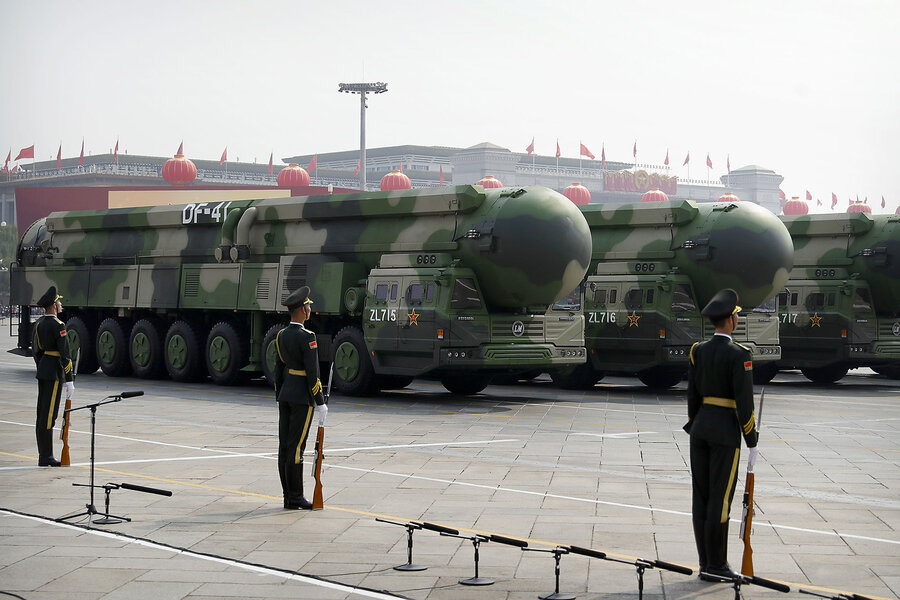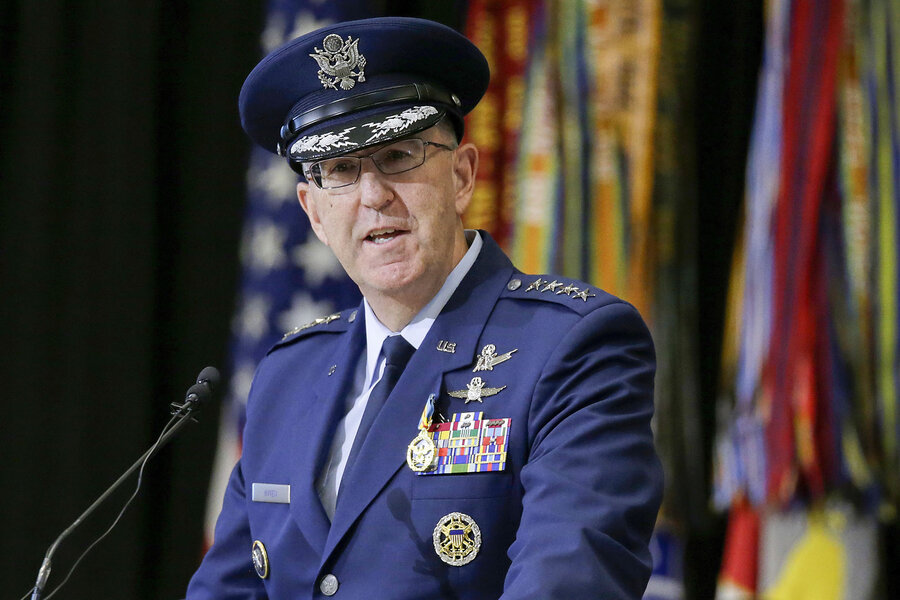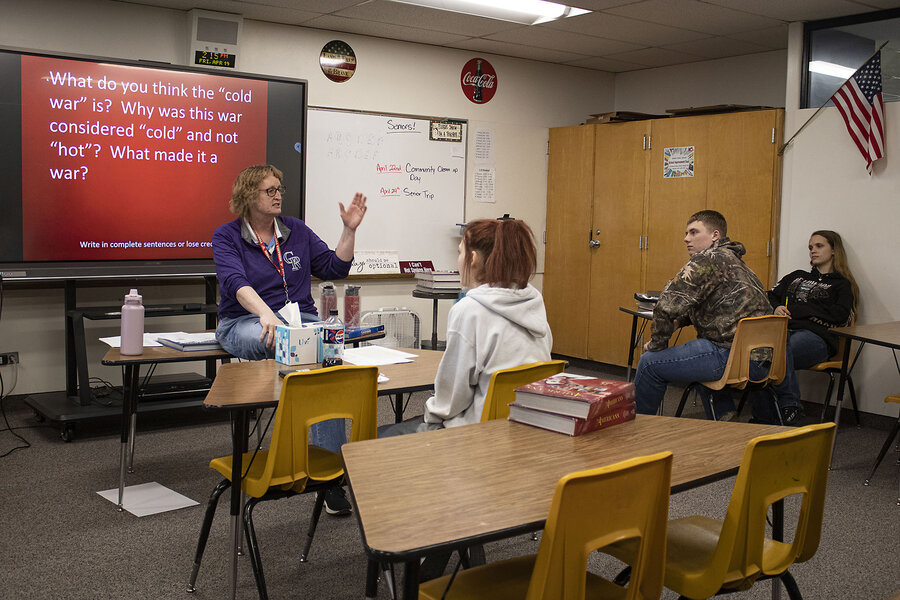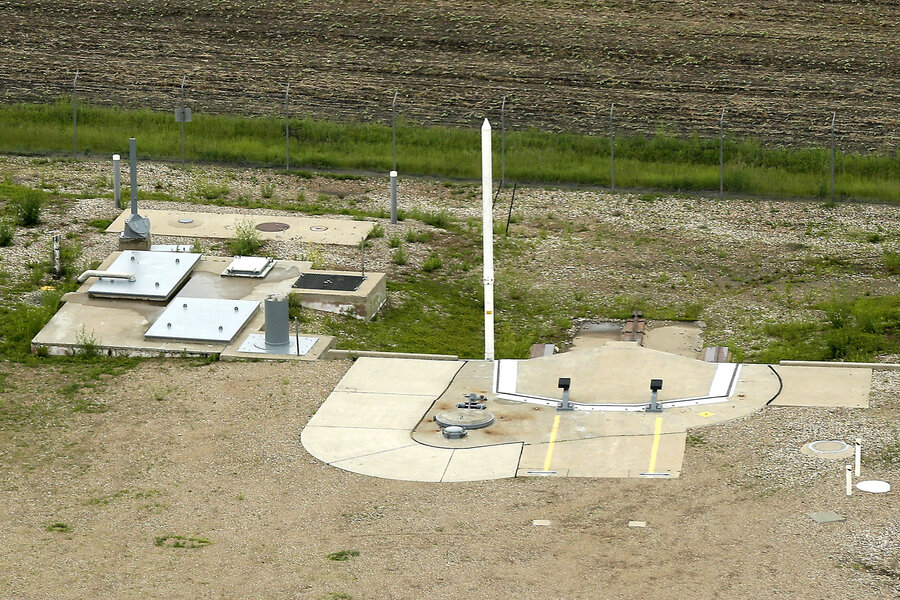The Cold War never fully thawed in this single-stoplight town, nestled in a county of fewer than 4,000 people that seems built for a populace twice its size. Empty storefronts tell that story of six decades ago, when the nuclear missiles moved in.
The weapons lie scattered beneath the high plains here – some a few miles from a school. Up to 400 of these intercontinental ballistic missiles, or ICBMs, remain on alert in rural parts of the American West, ready to launch at the president’s call.
Some outsiders may see Kimball as a sacrifice. Rich Flores calls his community “patriotic.”
Why We Wrote This
A story focused on
The risks of nuclear weapons have reappeared in global headlines. Containing those risks may hinge on transparency and communication as well as a “peace through strength” tradition.
“The people here, in my opinion, believe that we have ‘peace through strength,’” says Mr. Flores, a county commissioner, echoing a line popularized by President Ronald Reagan. As he chats over coffee, an American flag pin glints from his chest.
“Who wants to attack a country that’s strong?”
This is the logic of deterrence in a nutshell. Though the staggering cost of an upcoming missile upgrade in this region has ignited discussion about the necessity of America’s vast nuclear arsenal, the fact that the nation hasn’t used these weapons since World War II seems to deepen, for many, trust in their necessity.
But as global conflicts involving nuclear powers escalate, this trust is being tested. In Kimball and beyond, questions about America’s nuclear strategy – and how people feel about it – are taking on more urgency as concern about the likelihood of a nuclear attack is on the rise.
Senior U.S. military officials describe the world’s nuclear landscape as “breathtaking” in its potential for escalation. The United States, they warn, is now on the verge of having not one but two nuclear “peer” adversaries, as the Department of Defense calls them. China’s rapid buildup of its nuclear forces means it could have at least as many ICBMs as either the U.S. or Russia by the decade’s end, analysts say. Russian President Vladimir Putin is expanding his nuclear arsenal and rattling these sabers toward the West in his war against Ukraine.
As a result, the U.S. now faces threats that it “did not anticipate and for which it is not prepared,” a bipartisan commission appointed by Congress concluded last autumn.
While risk of a “major nuclear conflict remains low,” the nation needs to “urgently” prepare to take on adversaries who want to impose undemocratic values on the free world, according to the report.

United Nations Institute for Disarmament Research, Federation of American Scientists | Jacob Turcotte/Staff
Part of that preparation will occur around Kimball, which is set to see nearby missile fields upgraded over the next decade with a new weapon system called Sentinel.
Advocates for nonproliferation say America has more than enough nuclear weapons to deter opponents. Their imperative, rather, is reopening communication lines – laying the groundwork for lapsing or nonexistent arms control agreements – to restore a sense of safety and trust in what can seem like a precarious time. And some see promising developments along these lines.
“One of the most important things that we can do is to head off unconstrained nuclear competition between the U.S., Russia, and China,” says Daryl Kimball, executive director of the Arms Control Association.
“Taboos against nuclear weapons still exist,” he adds, “and each generation needs to ensure they’re not broken.”

Mark Schiefelbein/AP/File
Chinese military vehicles carrying DF-41 ballistic missiles roll during a parade to commemorate the 70th anniversary of the founding of communist China in Beijing, Oct. 1, 2019.
American trust in nuclear weapons
In the nearly 80 years since the U.S. dropped the only two nuclear weapons ever used in war, movements to abolish or champion nukes have ebbed and flowed.
Currently, Americans grapple with mixed views about the country’s nuclear weapons. A Chicago Council-Carnegie Corporation survey last year showed that 47% of U.S. adults believe the nuclear arsenal makes the U.S. safer. (Older adults are more likely than younger adults to say this.)
Moreover, China and Russia aren’t the only countries that worry Americans, who rank the development of nuclear programs in Iran and North Korea as two of the top three “critical threats” to the U.S., according to Gallup.
As U.S. leaders face a public that’s conflicted about trusting in deterrence, better communicating the country’s nuclear capabilities, some say, could help.
Nuclear nonchalance or confidence?
Retired Gen. John Hyten, who had been serving as vice chairman of the Joint Chiefs of Staff since 2019, recalls receiving a July 2021 phone call “so important that I went running to” the chairman and the secretary of defense after hanging up.

Air Force Gen. John Hyten speaks during a change of command ceremony at Offutt Air Force Base in Nebraska, Nov. 18, 2019. Now retired, he is a former commander of the U.S. Strategic Command.
It was top-secret news of “the most significant launch that had happened during my lifetime”: a Chinese hypersonic missile designed to elude U.S. detection systems and potentially be used as a first-strike weapon in a nuclear war.
It threatened the land-based leg of the U.S. nuclear triad, which is composed of ICBMs, like those kept around Kimball, as well as stealth bombers and nuclear-armed submarines.
General Hyten spent the last three months of his tenure working to get news of China’s hypersonic missile declassified, he said in a February discussion at the University of Virginia’s Miller Center.
In November 2021, he got the Pentagon green light to air his concerns on CBS News. The sense after the broadcast was that it was going to “create a ruckus in this country like nobody’s seen before,” he recalled. “And like three days later, it had disappeared from the news.”
He grapples with nuclear nonchalance in America, but admires the general trust that citizens seem to have in the government’s ability to keep them safe.
“You know, I actually want to be the citizen of a country where people … don’t worry about this stuff. They go to bed at night, and they sleep like babies,” he said. “But somebody’s got to think about it.”
Feeling like a target
As a high school social studies teacher in Kimball, Jeri Ferguson is one of those people who thinks about the question of trust in nuclear arms. She recalls safety-in-numbers logic that could evoke either confidence or unease during the Cold War.
“I was in my car, driving in college, and with the radio on: ‘Russia has enough nuclear weapons to kill us four times over. But we have enough to kill them 10 times over,’” she recalls. “I remember thinking, ‘Once is probably enough for me!’”
On a recent afternoon, Ms. Ferguson began a unit on that history with a class of seven juniors.
“What do you think the Cold War was about?” she asks the group. “Global warming?”

Sarah Matusek/The Christian Science Monitor
Jeri Ferguson, a high school social studies teacher, starts a unit on the Cold War with her class of juniors in Kimball, Nebraska, April 19, 2024.
No, the class groans, and volleys back more jokes. It was about “power,” says a boy. “During the winter!”
The teacher turns the focus closer to home – the Sentinel upgrade that could swell the local population with workers. The class seems vaguely aware of the missile silos scattered across the county.
“If there’s a nuclear war, guess where the first bombs are coming?”
“Us,” a student says. The jokes hit pause.
Restoring transparency – and talking to each other
The renewed conversation about nuclear arms in America points to a tension between the fear these devastating weapons inspire and the belief that the country wouldn’t be safe without them.
These are concerns that hint at the importance of bolstering transparency and communication to build trust not just in the weapons but among humans, too.
The global nuclear stockpile has declined significantly since the Cold War, from roughly 70,300 warheads in 1986 to some 12,100 in 2024, the Federation of American Scientists estimates. But most of these reductions happened in the 1990s. Since then, the pace has slowed.
Transparency is also on the decline. While the U.S. used to make its stockpile size public, this stopped under the Trump presidency. The Biden administration restored these disclosures at first, but then suspended them again.
While it’s difficult to know precise reasons the government is now refusing declassification requests, it may be that the transparency is politically difficult to justify given Russian and Chinese opacity, says Matt Korda, senior research fellow in the Nuclear Information Project at the federation.
The State Department, in a written response to the Monitor, said that declassification “does not occur on a planned calendar” and that the “value of transparency and its contributions to stability is increased when OTHER states take parallel steps.”
That said, a State Department official added on background that the U.S. “continues to view transparency among nuclear weapon states as extremely valuable for purposes of building confidence, avoiding misperception, and encouraging dialogue that can help mitigate the risk of costly arms competitions.”
Transparency, in other words, can be diplomatically productive. Exposing Chinese officials to complex internal U.S. policy debates could help catalyze China’s internal discussions, says Tong Zhao, senior fellow with the Nuclear Policy Program at Carnegie Endowment for International Peace.

An ICBM launch site is located among fields in the countryside outside Minot, North Dakota.
There are movements on this front. At a summit last November, U.S. and Chinese diplomats discussed whether states are at risk of ceding too much nuclear oversight to artificial intelligence systems. Though no agreements came of it, China’s willingness to discuss high-level principles of conduct could potentially be a productive wedge issue into other discussions, Dr. Zhao adds.
Russia for now appears to be stiff-arming the idea of nonproliferation talks with Washington, citing U.S. support for Ukraine, even as the sole remaining arms control agreement between the U.S. and Russia – the New START Treaty – will expire in February 2026.
The prospects for treaty renewal look remote for now, but surprising breakthroughs have emerged before. Even after President Reagan called the USSR an “evil empire,” for example, the two nations in 1985 agreed that “a nuclear war cannot be won and must never be fought,” notes Dan Smith, director of the Stockholm International Peace Research Institute.
Though straightforward, this sentence was considered a landmark declaration, and Russia, China, the U.S., France, and the United Kingdom reaffirmed it in 2022. Beyond being a hopeful signal, these sorts of statements “actually inform the thinking” of governments, Mr. Smith adds.
“Keep engagement alive”
At the same time, these governments are wrestling with the prospect of increasing U.S. isolationism, which many analysts point to as one of the most troubling deterrence trends.
The possibility of a Trump presidency, for example, is prompting European allies, who benefit from America’s nuclear umbrella, to question whether it will hold – or whether they should pursue their own nuclear programs.
It doesn’t help that Ukraine, which voluntarily gave up its nuclear weapons after the dissolution of the Soviet Union, is now bearing the brunt of as yet unsated Russian aggression.
Countering isolationist inclinations will mean renewed civic education, cultural dialogue of the sort that emerged in wake of the recent “Oppenheimer” film, and more, says William Hartung, senior research fellow at the Quincy Institute for Responsible Statecraft.
In places like Kimball, there’s less opportunity for disengagement.
Student Jessica Terrill says she’s used to seeing missile silos, like one near her aunt’s house.
“That’s definitely kind of scary sometimes,” says the high school senior. “It’s like, oh man. If those go off, we’re going to know.”
>>> Read full article>>>
Copyright for syndicated content belongs to the linked Source : The Christian Science Monitor – https://www.csmonitor.com/USA/Military/2024/0502/nuclear-weapons-deterrence-china-russia?icid=rss






























